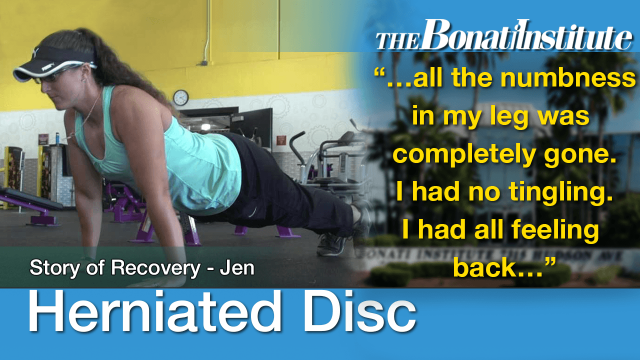Jen’s multiple herniated disc surgery story is a unique one. She is a multi-sport athlete that was dealing with debilitating pain, a result of a pinched nerve in her lower back.
She had multiple herniated discs in her lumbar spine. Her disc herniations were at L4/L5 and L5/S1. Jen had a number of symptoms resulting from multiple herniated disc in her lumbar spine, which included, “a lot of numbness and tingling going from my low back all the way to the top of my knee down the side. It was kind of a stabbing pain.”
A herniated disc is when a disc bulges out from between the vertebrae and constricts the spinal nerves located very close to the disc. Therefore, the spinal nerves and spinal cord become compressed causing pain, numbness, weakness.
Lumbar herniated discs are a common problem in healthcare. They most often affect people aged 35-50. While a lumbar herniated disc is painful, the symptoms do not usually last long. Approximately 90% of patients diagnosed with a lumbar herniated disc have no symptoms after 6 weeks, even if they do not seek treatment.
It is not unusual to have a lumbar disc herniation and have no symptoms. The symptoms may be triggered by moving or lifting something heavy and/or twisting the lower back. Herniated discs occur most often in the lumbar spine. They commonly inflame or press against a nearby nerve and cause pain to radiate along the length of the nerve. This is the most common cause of sciatica, pain that radiates down the leg along the sciatic nerve.
Symptoms of lumbar herniated discs include:
Leg pain – although the herniated disc is in the back, the leg pain is usually worse than the back pain. Pain that radiates down the back of the leg is generally called lumbar radiculopathy or sciatica.
Nerve pain – sharp, shearing, electric, piecing or radicular pain is the most common symptom described for a herniated disc.
Variable location of symptoms – depending on the degree of the herniation and where the disc herniates, patients may experience symptoms in the low back, buttock, back or front of the thigh, the calf, foot and/or toes. The symptoms generally affect only one side of the body.
Neurological symptoms – tingling, numbness, pins-and-needles, and weakness in the leg, foot, and/or toes.
Foot drop – patients may experience difficulty lifting the foot when standing or walking on the ball of the foot.
Find Long-Term Relief from Herniated Discs
If non-surgical treatments such as exercise, physical therapy, and medications do not relieve your pain, surgery may be necessary. The Bonati Spine Institute has been a leader in advanced spine surgery for decades, with more than 70,000 successful surgical procedures performed. The Bonati Spine Procedures achieve a very high success rate in the surgical treatment of herniated discs.
The physicians at The Bonati Spine Institute may perform a variety of procedures for treating herniated discs, including:
A discectomy – a surgical procedure performed to remove a portion of the bulged or herniated disc.
A foraminotomy – a decompression surgery performed in order to increase the space of the foramen and hollow out the passageway where the nerve roots exit the spinal canal.
A laminectomy/laminotomy – removes or trims part of the lamina (roof) of the vertebrae in the compressed area.
After her exclusive Bonati Spine procedures, Jen says,” “…all the numbness in my leg is completely gone. I had no tingling. I had all feeling back.”
If you would like to know if you are a candidate for the Bonati Spine Procedures, please contact us here or call (855) 267-0482.

